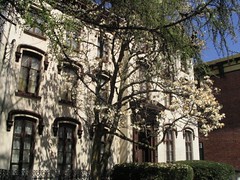Better late than never, Councilman Zecca is backing up his long-time call for a Boulevard-style alternative to the North-South Arterial with a resolution for the Common Council to vote upon.
Amazingly, before the ink on the resolution is even dry (and before even writing a story about it),
the OD Edictorial Board has pronounced "Time to move ahead with state plan for arterial"calling for the Council to "soundly defeat that measure."
It's no secret that the current City Hall administration has supported the State's latest concept from the beginning. Repeated efforts going back years to expressly incorporate a Boulevard as an Arterial replacement into the draft Utica Master Plan were not only ignored, they were rebuffed by city officials and their hired hands, allowing the State to respond in kind. Proponents of the State's plan, knowing that the "fix was in," largely absented themselves from discussions which
prevented exploration of alternatives that would meet all the needs of the Neighborhood, the City, and the Region.
As it stands now, plans call for dead-ending Sunset Ave. and Warren St., a pedestrian-only bridge at Sunset, an extension of New Hartford's recreational Rayhill Trail into Downtown Utica, a highway interchange and bridge over Court St., replacement of existing bridges, but a stone wall in place of existing pylons to support all overhead structures.
Debate on the Arterial sounds a lot like that of 50 years ago... Only now Utica has a 50 year history to draw upon. Arterials have resulted in the loss of 100s of properties from the tax base, rerouting of countless streets with disruption of established traffic patterns, gutting of business districts destroying the "critical mass" needed to sustain economic activity, and the displacement of economic activity to the suburbs. Only suburban developers have benefitted.
West Utica is just starting to show signs of rebirth, in the
Brewery District with its entertainment venues and Sculpture Space, and in the
Arts District spurred by Pratt at MWPAI and the new Player's Theater. This rebirth will take time and involve a lot of trial-and-error risks (and no-doubt, losses) by individual entrepreneurs -- but it
is starting and it is
natural growth -- the kind that built Utica in the first place -- not instant characterless suburban-style development growth.
Growth in the Arts District will be to the northwest -- toward the Arterial. Growth in the Brewery District will be to the southeast -- toward the Arterial. Land uses about the Arterial are an unusual mix of residential, retail, and industrial -- with lot sizes that are generally small. This area is perfect for entrepreneurial artisans to take risks and set up studios, small manufacturing facilities, shops, and residences.
But if a highway gobbles up the properties and a wall is erected between the Arts and Brewery Districts, the potential for synergy and growth -- and the potential for an artisan-oriented "destination" to develop -- will be forever lost.
Neighborhood convenience and potential is being sacrificed for shaving 2-3 minutes off the suburban commute to Downtown attractions. Is this fair? West Utica is one of the poorest areas in an already-poor city which, from a federal perspective, should raise so-called "environmental justice" concerns over the State's plans.
There are plenty of ways to address public safety and move traffic without destroying a neighborhood.
Councilman Zecca
is giving the Utica Common Council its first real opportunity to officially voice its position on the Arterial project. Residents who oppose the State's plan need to turn out 6PM Wednesday if this is important to them. It will be interesting to see who supports the State's current plans, and what their rationales are. Who will place suburban interests above the needs of City residents?
Will Utica's interests be sacrificed again for an alleged "regional" good?
What is best for Utica IS what is best for the region.







